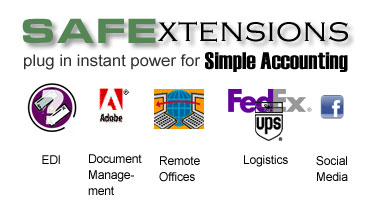This program is used to convert the data currently displayed in the current browse into a format that is compatible with other programs you may be using such as spreadsheets and word processors. This function is available from most, but not all main browse windows in Simple Accounting under the [Print] button with other reports.
You can also export any printed report to a file by printing the report with Print Preview turned on. Printing a report to a file limits you to the columns on that report, whereas Export allows you to control precisely which fields will be exported.
The data export process offers five types of file conversions:
- Plain ASCII (SDF) This creates a text file with one line for each record and no spaces between data fields. This format is compatible with any program that can read in ASCII text, including word processors and report writers; however, it may take some experimentation to format the data into extract individual fields from a group of records.
You can also print any report to an ASCII file, in Simple Accounting, from Print Preview, so you may want to look there for other options to getting data out of Simple Accounting.
- Comma Delimited This creates a text file with one line per record, with quotes and commas used to separate (delimit) each field. This format can be easily imported into most database and spreadsheet programs, as well as many commercial accounting applications. In Lotus 123, for example, select the File Import function and the Comma/Quote Delimited option to create a worksheet from your exported file.
- Tab Delimited Similar to Plain ASCII, except that each field is separated by a tab character.
- WordPerfect® Merge This format creates a text file consisting of WordPerfect {END FIELD} and {END RECORD} codes. This file can then be used as a secondary merge file for versions 4.2, 5.0, and 5.1 documents.
- dBASE/FoxPro® This format creates a data file in FoxPro or dBASE III+ format.
By default the export file name is the original data file name with the extension .EXP except for dBASE/FoxPro exported fields (these have the extension .DBF.) So if the original data file is named ‘CONTACTS.TPS’ and you are exporting in ASCII SDF format, the default name for the exported file would be ‘CONTACTS.EXP’.
Records are exported as they are displayed in the browse. For example, if you are in the Contacts Browse, you can easily create an export file of all records in ORGANIZATION NAME by simply viewing the Name tab. To select only certain records to export, build the query in the Query tab, and then Export.
Warning: If you enter an export file name which already exists, the existing file will be overwritten when you run this process!
Procedure
1) To begin, you must first enter your Master Password. This is to prevent sensitive data from being copied without proper clearance.
2) Copy the fields you wish to export from the Source Fields list on the left hand side of the window to the Export Fields list on the right. You can copy a field to the Export Fields window by either:
Selecting a field then pressing the [Select] button or
Double-click on a field or
Drag the field from the Source Fields window over to the Export fields window.
You can also press the [Select All] button to copy all fields to the Export Fields list in one step.
The Export Fields appear in the order in which you copied them from the Source Fields list. Be certain this is the order you need for your application, or delete and re-copy until it is.
3) Select the type of export file to create using thedrop-down-list.
4) If you are selecting the Plain ASCII, Comma Delimited, or Tab Delimited record types, you can include a Header Record. This includes the names of the export files data fields at the top of the export file. Your word processor or spreadsheet can read these field names, making it possible for you to specify placement of specific fields by their name in your document.
5) Press the [Proceed] button. This begins the export process using the records from the selected browse tab. A progress bar shows you the status of the records as they are exported.
Copying An Export File To A Floppy Disk
 Data that you export from Simple Accounting is, by default, sent to files with an EXP extension. To find Export files and copy them to a floppy disk, follow these steps:
Data that you export from Simple Accounting is, by default, sent to files with an EXP extension. To find Export files and copy them to a floppy disk, follow these steps:
1. Press the [Start] button from the Task Bar, then [Find], then [Files & Folders]. The Find:All Files window should appear.
2. In the Named: field, type *.EXP, then press [Find Now].
3. When the file(s) appears in the browse, select one and right click on it. A menu will appear.
4. From the menu, click on [Send To], then [Floppy Drive] (usually 3½ Floppy). The file will then be copied to your diskette.



